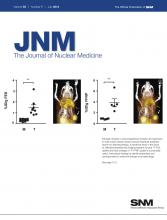PET/CT staging in NSCLC: Gregory and colleagues detail the effect on management and prognostic value of 18F-FDG PET/CT staging in patients with non–small cell lung cancer being considered for potentially curative therapies.Page 1007
PET and RCTs: Scheibler and colleagues provide an overview of the numbers, clinical topics, design, and quality of current randomized controlled trials evaluating PET and PET/CT.Page 1016
Hybrid sentinel node mapping: Buckle and colleagues describe intraprostatic injection of indocyanine green–99mTc-nanocolloid to enable both preoperative sentinel node identification and intraoperative visualization.Page 1026
Hybrid sentinel node tracer validation: Brouwer and colleagues compare the lymphoscintigraphic drainage patterns of fluorescent indocyanine green and 99mTc-nanocolloid with the drainage pattern of 99mTc-nanocolloid alone in patients with melanoma or penile carcinoma.Page 1034

Noise considerations in PET quantification: Lodge and colleagues measure aspects of bias and reproducibility associated with maximum and peak 18F-FDG PET SUVs using clinical treatment monitoring data to provide realistic noise contexts.Page 1041
Response assessment with 18F-FET PET: Galldiks and colleagues explore the predictive value of 18F-FET PET in determining treatment response in glioblastoma and compare results with those obtained using MRI.Page 1048
Recurrent gliomas and 11C-AMT PET: Alkonyi and colleagues evaluate the utility of α-11C-methyl-l-tryptophan PET supplemented by tracer kinetic analysis for distinguishing recurrent gliomas from radiation injury.Page 1058

18F-FE-PE2I in humans: Sasaki and colleagues look at quantification of dopamine transporters in human volunteers, with a new PET radioligand that in animal studies has shown fast kinetics and low production of radiometabolites.Page 1065
PET and MRI in SCA17: Brockmann and colleagues assess functional and morphologic imaging characteristics to identify evidence of neurodegeneration in early stages of spinocerebellar ataxia type 17, a rare autosomal disorder.Page 1074
Calcium score and preoperative risk: Ghadri and colleagues research the added value of coronary artery calcium score as an adjunct to SPECT myocardial perfusion imaging for cardiac risk stratification before noncardiac surgery.Page 1081
123I-FP-CIT SPECT SERT measurement: Koopman and colleagues examine the extrastriatal binding of this agent commonly used to assess striatal dopamine transporter binding to determine optimal time points for SPECT measurement of serotonin transporter binding.Page 1087
Imaging multiple myeloma: Walker and colleagues present an educational overview of imaging of multiple myeloma and related plasma cell dyscrasias, including the role of advanced imaging in diagnosis, staging, and restaging.Page 1091
Quantitative in vivo PET/MR: Ng and colleagues describe and evaluate the ability of a first-generation, small-animal MRI-compatible PET scanner to accurately depict heterogeneous patterns of radiotracer uptake in tumors.Page 1102

18F-Affibody for EGFR imaging: Miao and colleagues report on the successful site-specific labeling of an Affibody analog for PET imaging of epidermal growth factor receptors and review the potential for translation to clinical use.Page 1110
ER/PR PET and endocrine therapy: Fowler and colleagues use estrogen- and progestin-based radiopharmaceuticals to image estrogen receptor-α and progesterone receptor in mouse mammary tumors during hormonal therapy to determine whether changes can predict therapeutic response.Page 1119
Folate receptor-α–specific targeting ligand: Vaitilingam and colleagues detail the development of a reduced and alkylated form of folic acid for use in a targeting ligand to selectively deliver attached imaging and therapeutic agents to tumor cells.Page 1127

Growth dynamics of glioblastomas: Viel and colleagues use multimodal small animal PET and MRI to analyze the growth of angiogenesis-dependent and -independent experimental glioblastomas at various stages.Page 1135
PARP-1 and 131I-MIBG/topotecan: McCluskey and colleagues report on the potential of polyadenosine diphosphate ribose polymerase inhibition as a means to enhance targeted therapy with 131I-MIBG and the topoisomerase I inhibitor topotecan.Page 1146
No-carrier-added 131I-MIBG: Matthay and colleagues establish the maximum tolerated dose of no-carrier-added 131I-MIBG in patients with resistant neuroblastoma and assess tumor and organ dosimetry and overall response.Page 1155
ON THE COVER

Estrogen receptor-α and progesterone receptor are expressed in most human breast cancers and are important predictive factors for directing therapy. A preclinical study in this issue of JNM demonstrates that imaging baseline tumoral 18F-FES uptake and initial changes in 18F-FFNP uptake is a potentially useful, noninvasive strategy to identify responders and nonresponders to endocrine therapy at an early stage.
See page 1121.
- © 2012 by the Society of Nuclear Medicine, Inc.







